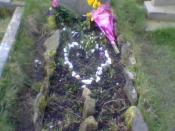�PAGE �1� Kathryn Styer Styer Dr. V Kasbekar Eng. 200 2 May 2007 �PAGE �4� Styer �PAGE �3� Styer
Analysis of "Daddy"
"Daddy" (1965), is a fascinating autobiographical poem written by Sylvia Plath (1932-1963). Plath's remarkable use of intense emotions towards her father's life and death and her disastrous relationship with her husband paints a detailed picture for the reader. Using regular stanzaic structure with an irregular rhyme scheme, Plath illustrates her feelings of anger and resentment towards her father and husband. Her creative use vivid metaphors, imagery, rhyme, tone, and simile contribute to making "Daddy" a very powerful poem. Plath's brilliant use of metaphor plays an important role in this poem, as strong metaphors are conveyed throughout the poem. Plath begins the poem by telling the reader about her life for thirty years without her father. She was poor, and lived like a "foot" in a "shoe" unable to breathe because she felt so claustrophobic in her own life.
This metaphor evokes multiple helpful connections. Generally, a shoe protects the foot and keeps it warm; However, Plath describes the shoe as a trap, smothering the foot. Consequently, maybe Plath is feeling both protected and smothered by the memory of her father.
The artistic use of graphic imaginary invites to reader to relate to Plath's harsh life. In the second stanza Plath incorporates images of the way she remembers her father, "Ghastly statue with one grey toe," (Plath 808) is referring to gangrene in his toe that contributed to the amputation of his leg (Axelrod). Plath then describes her husband and father using the color black. "Black" could be representing a void in her life, like the hole that Hughes made when he left her and the hole that her father left when he died. Another powerful image is introduced...


